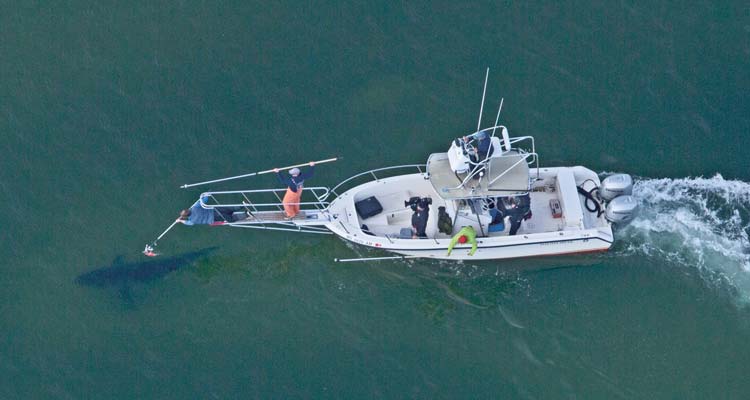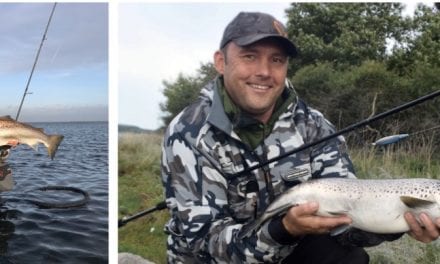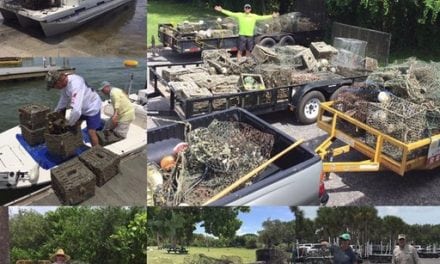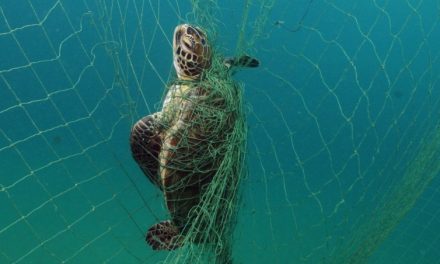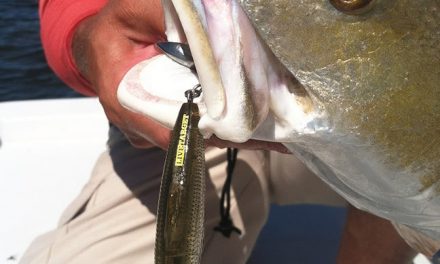Pictured above: Guided by spotter pilot Wayne Davis, researchers from the Massachusetts Division of Marine Fisheries place a tag on a white shark.
Pilot and photographer Wayne Davis lends his talents to researchers studying the white sharks of Cape Cod.
Wayne Davis grew up “down The Point” in the early 1950s, when Rhode Island’s Pt. Judith Harbor was a wide-open landscape of lobstermen, fish trappers, quahoggers and draggers, wharves, and fish houses. Fishing made for a good living, so Davis went from high school to the deck of Joe Whaley’s E. Carl Rice Jr., a classic wooden eastern rig. Like those before him, he worked hard inshore and offshore, but one day he realized there was a good living to be made overhead, not in the rigging but in the skies. Now, after more than 40 years of fish spotting, looking for pods of tuna, piles of herring, schools of mackerel and single sleeping swords, Davis cruises above Cape Cod’s shallow shoreline and busy beaches searching for white sharks.
Fishing for a living can seem romantic, with its endless horizons, sunrises and sunsets, squalls and spouting whales. In reality, it’s some of the hardest work imaginable. Davis saved every penny he made fishing before he left to serve with the Army in 1967.
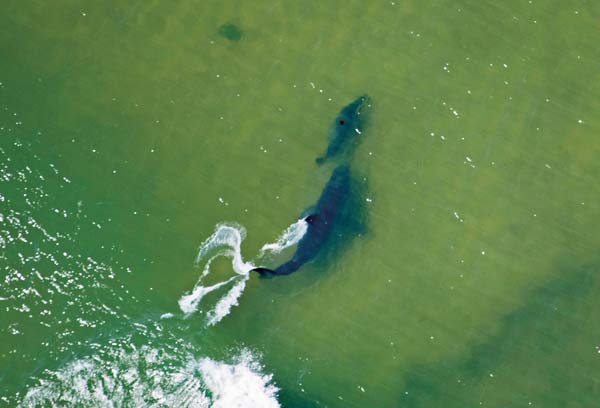
In the shallow waters off Cape Cod’s beaches, white sharks feed primarily on seals. Photo by Wayne Davis
Fuel was still cheap when he returned from the service and started fishing. As costs increased, hiring a spotter pilot made good economic sense. Davis saw an opportunity, stopped fishing for a few months, went to Florida to earn a pilot’s license, then in 1973 bought a brand-new airplane with a $10,000 loan from his brother, Walt. With Forrest Hoxie, who fish-spotted for Chet Westcott on the Roann, to mentor him, Davis began a new life as a pilot and fisherman.
“I was always enthralled by airplanes,” he said. “When I was a kid, I saw these guys spotting and said, ‘Yeah, I can do that.’” Harpooners spend hours squinting for swordfish lazing in the sun while captains watch for temperature breaks, contour lines, or birds over frantic bait balls, but pilots can see it all from above.
“I spent twenty years looking for swordfish for commercial fishermen to harpoon, and then it was tuna fish. Fish spotters are hired to make fishing efficient enough to earn money,” Davis said. From 1973 to 1992, he spotted fish through the summer season, then went back on deck to work through the coldest, hardest months of the year.
“We used to fly so freaking much. We didn’t get many days off, and worked ten or twelve hours a day,” he said. In 1987, he purchased a 1969 Citabria NI592X, noted for its nimble handling and maneuverability—perfect for flying just off the beach.
Wayne Davis has a way. His “yesses” and “noes” are hard hits on the ears. He makes sure you’re paying attention all the time, but that’s how pilots and fishermen work. He exudes happiness with a level of excitement that draws you in and keeps you there and, when he’s really moving, you can’t help but be caught up in his wake.
“Wayne is probably the best pilot in the air,” said Greg Skomal, Senior Marine Fisheries Biologist and Program Manager for the Massachusetts Shark Research Program. Skomal works cooperatively with Cynthia Wigren of the Atlantic White Shark Conservancy, John King, captain of the Aleutian Dream, and Megan Winton, a doctoral candidate researching shark populations. As a group, their goal since 2007 has been to identify and count individual sharks from markings, scars, and measurements. This will be Davis’s fourth summer spotting for them, and in Skomal’s words, “You can’t solve the equation without Wayne.”
Wayne Davis has a unique, crucial relationship with the team; this is expensive research below, on and above the water. Trust among all is critical, not just for safety’s sake, but also for the pursuit of honest, pure, defendable research. He abhors what he calls Hollywood science, where waters are chummed to draw in sharks, muddying them with artificial conditions. “Trust is tough,” said Skomal. Researchers must trust everything they see, and they do, without question.
“We’ve gone out as many as five days a week when we’ve had film crews wanting to come out, you know, Disney, Discovery Channel, who the hell else…”, Davis trails off. Typically, he flies about six hours per day, two days per week, and every time Davis calls the team to a shark, a notation is made with time and coordinates, all part of Skomal’s “Mark Recapture Vessel Survey.” Quickly, a hydrophone is deployed to determine if the shark has previously been tagged and can be identified by a distinctive ping. Leaning against the forward rail of the Aleutian Dream’s ten-foot pulpit with a GoPro camera mounted on a 14-foot pole, Skomal works to record everything.
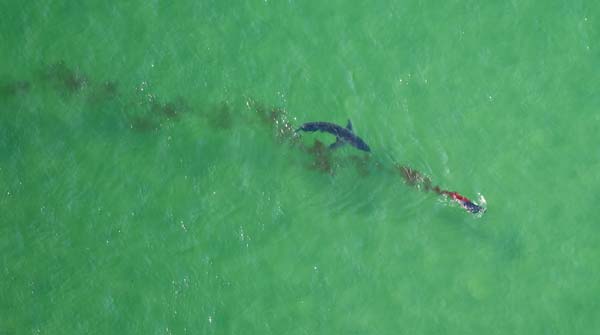
Over eight years of shark spotting, the team has observed relatively few predation events. Photo by Wayne Davis
From Halifax, Nova Scotia, to the Gulf of Mexico, the Atlantic is dotted with an array of acoustic receivers that store data when a tagged shark passes within a few hundred meters. That data is tracked as part of Skomal’s and Winton’s research. All sharks are given a number, and several have been given names, such as Marianne, Cynthia, Big Poppy, Hardy, Brady, Rocky, Lumpy, Dolores (Spanish for “pain”), and Curly.
Since starting with the team, Davis has flown more than 700 hours. They’ve tagged 101 sharks so far (which happens to be the number of tags they had available), and 257 have been positively identified. The most sharks Davis spotted in a day was 23 individuals in just four miles of beach.
The research team has logged 572 shark spottings, what they call, “Davis Sightings,” but it’s agreed that Davis has likely seen three times that number. Surprisingly, the team has recorded very few predations; in eight years, they have witnessed only 13. In this region, sharks feed primarily on gray and harbor seals, which are feeding on sand lances and fish such as striped bass. Seals seem to know enough to leave the beach at night to feed, using darkness to their advantage.
White shark attacks are grisly, calculated affairs. Tens of thousands of beached seals omit smells attractive to sharks. Called closer by low-frequency vibration, sharks seem to rely heavily on sight as they approach. They’re able to swim at speeds near 35 miles per hour to attack and then retreat, leaving a seal to struggle and bleed. A seal swims in a bloodbath that a shark follows until the seal makes a final curve and stalls. On several trips, Davis has captured images of long, winding lines of blood with large, dark-gray shadows trailing behind.
Davis is adamant that images we’re fed about white sharks being man-eaters are incorrect and unfair. Simple math and basic instinct says a 700-pound seal laden with blubber and calories is a far more nutritious meal than a 170-pound retiree in a rubber bathing cap. Dozens of sharks on patrol does not mean imminent danger to beachgoers.
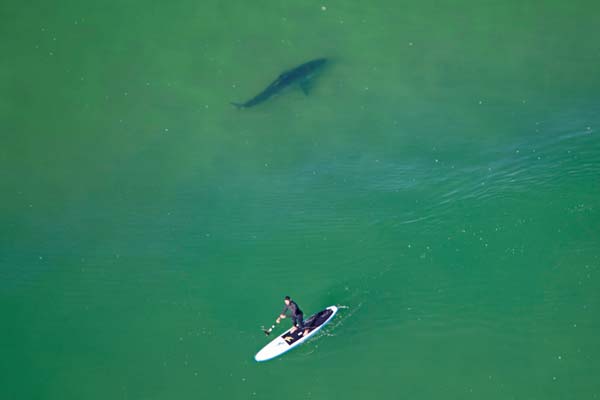
Davis photographed this paddleboarder off Chatham, Massachusetts, seemingly unaware of the white shark swimming nearby. Days later, the paddleboarder was quoted in a local paper as saying, “I knew the fish spotter wasn’t looking for me.” Photo by Wayne Davis
Many of Davis’s photographs show sand ridges, giving viewers an idea of just how shallow the water is, but rare is the shot of one running out of the water with a cascade of white trailing a dorsal fin up high. Slideshows of his photographs are startling for their range, clarity and subject matter. He’s a master pilot and despite his deflecting any praise, a superb photographer.
“I started out with a cheesy camera and just worked my way up,” Davis said. While adjusting focus, he’s also flying a plane at 85 knots, a thousand feet over a beach packed with bathers. His images of sharks stalking seals, of the Aleutian Dream’s pulpit dwarfed by a submerged figure, of seals torn in half, are simply striking.
Speaking to Davis across a round table, Skomal said, “Your capabilities to handle a camera, a long lens, and spot—don’t underrate that.” In typical style, Davis ignored his statement, saying, “The flying, that’s not a big deal. It’s the luck of timing the shot.”
Like most good fishermen, Davis remembers details like names and places, but more so the nuances of a scene or place, the same way captains recall pages of logbooks or productive ledges. However, when asked how many hours he has flown, an easy bragging point, he answers, “Over the years? No idea at all. That would be impossible to know.” He still occasionally flies for commercial fishermen, noting, “I kept my string going last year. I got out one day with a tuna fisherman and found one fish that he harpooned.”
There’s a good story behind everything Davis does. Just mentioning his name to ex-deckmates brings a cascade of laughter and “Wayne-isms.” There’s the story of the ragged and almost-sleeveless fleece jacket dragged up in a bag of fish and mud far offshore in 1982. Longtime shipmate Steve Babcock remembers Davis running to the jacket, yelling, “That’s mine!” and then wearing the jacket for years.
One year, he spent a winter in Plymouth, taking the plane apart, building new ribs, sandblasting everything, and painting his way out. “I was crawling around the floor and there was this little plaque, the manufacturer’s plaque,” he said. Right there in the metal was stamped May 9, 1969, the very day he came home from Vietnam.
Although time has changed the vessels and faces of Pt. Judith, Wayne Davis’s name and reputation rest securely. At 70, he’s one of the old dogs he affectionately refers to when recalling his youth in Galilee. “It’s a big world out there. I just keep doing it because I like flying.” With many other spotters having died or moved on, Davis is just about the last of them.
He was a kid on Georges Bank. He spent years working on deck. He perfected being a pilot. He earned a name for himself as simply the best spotter there was, to which he will quite loudly correct, “I’m still here, you know!”
This is Wayne’s fourth year flying for the five-year study, and he’s eager for more sightings, photos, and stories. Adjusting his cap and sunglasses, thinking about spotting white sharks, he says, “They’ve increased in number every year since we’ve been doing this, so what’s this year going to bring?”

